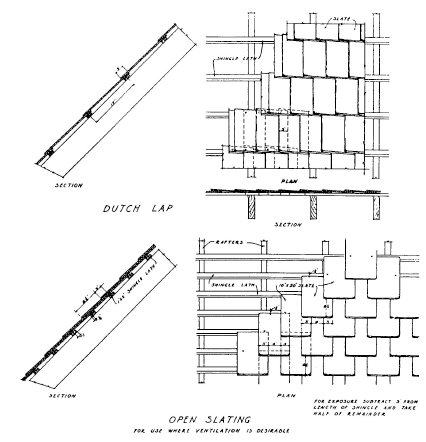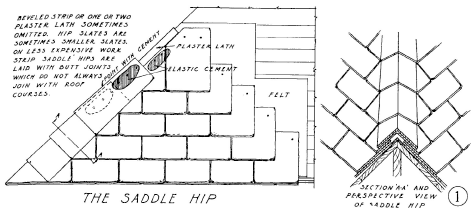Natural slate is one of the most durable materials used in roofing. Slate is manufactured by cutting and splitting slate rock quarried from naturally occurring deposits. Its beauty and permanence have led to its use in roofing throughout the world. In laying slate, the quality of workmanship is crucial. It is a mistake to think that those without the proper training and knowledge are qualified to properly lay slate. For instance, the nailing of slate is completely different than the nailing of asphalt or wooden shingles. Nails should never be driven into the surface of the slate. Instead, nails should be left so that their heads just clear the slate surface so that the tile hangs on the nail. Otherwise the tile will shatter around the hole and be subject to wind blow-off.
Roofing slate is available in a range of thicknesses and lengths. Roofing slate is graded in terms of its expected service life length.
Slate tiles are normally 4.8 mm (3/16 in) thick. Depending on the quarry, they come in standard or random widths and a variety of lengths. The standard lap for slate on sloped roofs is 75 mm (3 in). The slate headlap depends on roof slope. The standard 75 mm (3 in) headlap is appropriate for slopes from 8:12 to 20:12. A 100 mm (4 in) headlap is appropriate for roofing slate installed at slopes less than 8:12. To obtain the proper exposure of each course, 75 mm (3 in) is deducted from the length of each slate and then divided by two. For example, the exposure for a 600 mm (24 in) slate is 265 mm (10 ½ in).

Slate would not be considered a new product as it has been used as a roofing material for over hundreds of years. Slate deposits can be found worldwide. Slate is a natural stone that can be split into thicknesses of approximately 6 mm (1/4 in) in much the same way as a cedar shake is made. Slate tiles are laid in much the same way as cedar shakes in random widths. The joints in successive course should be laid a minimum of 38 mm (1 1/2 in) from the joints in the previous course.
Once installed, a slate roof requires little or no maintenance and slate tiles can be removed and cleaned then reinstalled. Slate tiles are usually secured (nailed) through a hole in the upper corner using a copper or stainless steel nail.

